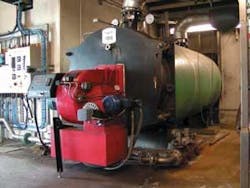Satisfying EU legislation saves power costs
By Peter J. Fennemore
Photo by Black & Veatch
Efforts to comply with European Union legislation regulating the use of sewage sludge in agricultural applications resulted in multiple benefits for Thames Water Utilities Ltd. and Black & Veatch - improved sludge thickening and digestion, increased biogas production, and savings in imported electrical energy.
The two companies worked together to upgrade the Mogden sewage treatment works in South London, England, specifically to meet EU regulations by improving sludge handling and treatment at the Mogden facility, which is designed to process flows of 810 million litres per day (Ml/d) for a local population of 1.8 million. Biogas fuels on-site combined heat and power (CHP) engines.
The sludge generated at Mogden works, built in the 1930s, contains organic matter, grit, sand and quantities of rags. This sludge is taken from on-site processes and from imported sludge delivered by tanker from a variety of locations. Sixteen of Mogden's twenty digesters (each having a working volume of 4,100m3) have been refurbished as digesters, two converted to emergency storage, and two decommissioned.
Grit and screening passing through the works accumulated in the digester tanks, resulting in reduced digestion capacity; however the removal of grit and the provision of 6-mm fine screens under a previous Black & Veatch project reduced grit and screenings carry over. Prior to refurbishment, the digester tanks were cleaned, and two years hence, the tanks are still operating at full capacity.
Dedicated heat exchangers and a gas mixing system were provided for each of the tanks as part of the digester refurbishment. All new plant is located external to the tanks, whereas the previous plant was internal and inaccessible,. The new heating system includes a heat exchanger rated to transfer a minimum of 638 kW of heat to the sludge. Heating water and sludge are circulated through the heat exchanger by dedicated pumps for each digester.
The gas mixing system uses a compressor, which draws gas from the bell of the digester and delivers it into the sludge by means of solenoid-controlled nozzles. The nozzle layout and solenoid operating sequence produces a "rolling boil" within the sludge producing a complete mixing of feed sludge into the digester volume within a period of two hours from introduction. A 3-MW dual fuel boiler, associated heat exchanger and up-rated sludge feed pumps were provided to pre-heat the sludge feed to the digesters. The boiler is capable of operation on biogas or fuel oil, with auto changeover from gas to oil in the event of low gas pressure.
The Mogden facility has four existing dual fuel Mirlees CHP engines, each capable of delivering 2.4 megawatts of electrical output (Mwe) and previously up to approximately 2 MW of heat recovered, 1.3 MW of which was recovered from the exhaust gasses. The exhaust gas waste heat boilers were replaced and upgraded to provide increased heat recovery from 1.3 MW to 1.9 MW, giving a maximum heat recovered from each engine of 2.6 MW.
Circulation water cools the engines, removing heat from the turbo inter-cooler, valve cage and jacket water. This cooling load results in more heat in circulation water than is required by the digestion process during summer months. Previously, heat accumulated in the water circuit and overheated the engine, resulting in consequential failure. Heat dump (to atmosphere) radiators rated at a total of 2.6 MW were provided to allow dissipation of the excess heat and to reduce outgoing pressure to the digester heating system when all digester heating is satisfied. A three-way valve, which is modulated subject to heat, controls the flow through the radiators and pressure conditions within the circulation water loop.
Individual control loops are provided for gas mixing and sludge heating of each digester and the in-line feed sludge heating boiler. All are controlled by a distributed control system consisting of programmable logic controllers contained in remote terminal units.
The beneficial spin-off from increased biogas production is the ability to operate CHP engines on biogas, a renewable resource, for longer periods. Arising from a new tariff structure for electrical consumption, Thames Water Operations recently employed Black & Veatch to reconfigure the site's high voltage distribution to take advantage of the "Embedded Generation" at the Mogden works during the next 12 months.
Author's Note
Peter J. Fennemore is the chief electrical engineer of Black & Veatch, located in Isleworth, Middlesex, England.

